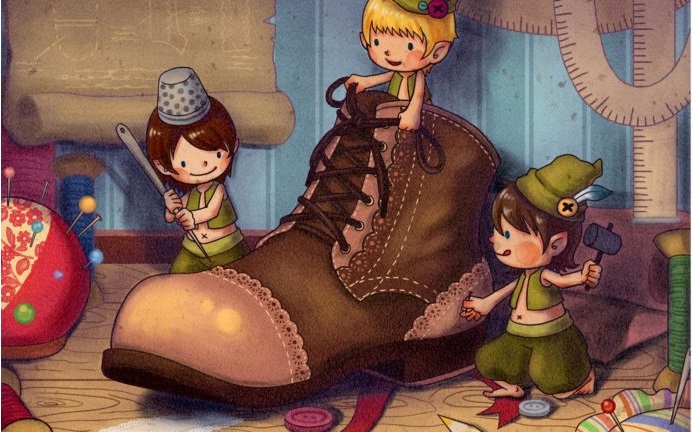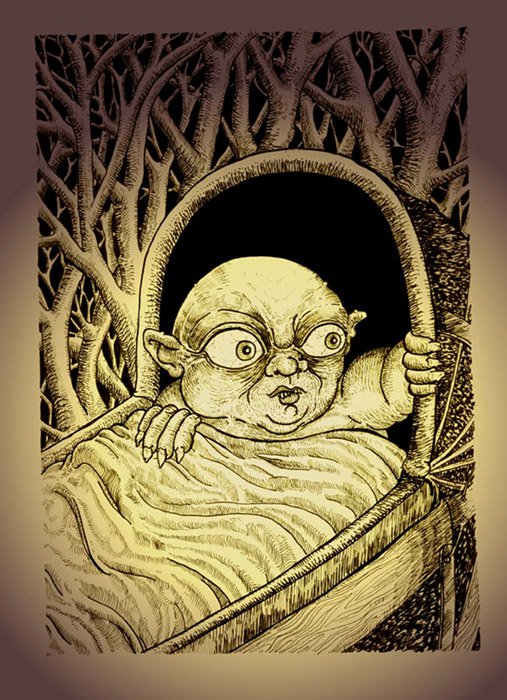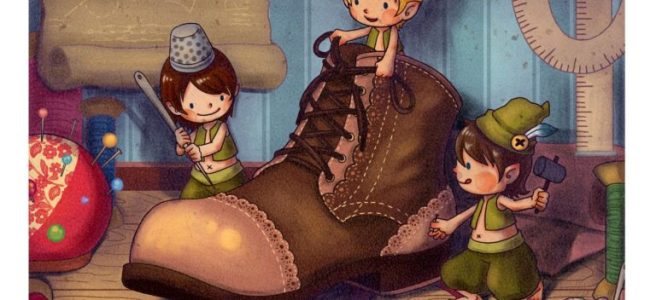It’s been awhile since I posted so here’s a reminder: I’ve been going through the Grimm’s 1812 volume of fairytales, one after the other for a few years. I’ll finish eventually but for now, let’s move on to some cobbler-elf shenanigans
This is one of those Grimm multi-part tales, which means multiple Aarne-Thompson-Uther Index classifications:
“The Shoemaker for Whom They Did Work,” type 503 (Helpful Elves), also classified as a migratory legend type 7015 (Domestic Spirits),
“The Servant Girl Who Stood In as Godmother for Them,” type 476 (A Midwife [or Godmother] for the Elves), also categorized as a migratory legend type 5070 (The Fairies),
“The Woman Whose Child They Exchanged,” type 504 (The Changeling), also categorized as a migratory legend type 5085 (The Fairies),
The most commonly known version of this story is the first one, which is usually referred to more succinctly as “The Elves and the Shoemaker.”

In this version, the cobbler and his wife are very poor and can barely afford to buy the leather that they need to make shoes. One night, he left a half-finished pair on his workbench and went to bed after he “commended himself to God.” In the morning he said a prayer after waking up and went to find a complete and perfect pair of shoes on his workbench. He was able to sell that pair for more than he usually did and the elves didn’t appear to want anything in return.
With the money he made for that sale, he was able to buy enough leather for two pairs of shoes, which the elves completed after the cobbler cut them out and left them on the bench. This went on for many nights, with an ever increasing number of shoes to the point that it begins to sound like a multi-level marketing scam but with shoes instead of essential oils.
After several months, the cobbler reaches a place of financial stability and comfort. Just before Christmas, the cobbler’s wife suggests that they finally stay up to get a peek at their mysterious benefactors. What they see are two tiny and very naked men who proceed to do a speed-run through shoe construction and then leave. The wife believes that they must be very cold and so she and her husband make adorable tiny little clothes and shoes and leave them out. The elves are delighted, put on their new finery, and dance out the door, forever, leaving a very prosperous cobbler behind.
The second version, “The Servant Girl Who Stood In as Godmother for Them” is wildly different but still involves mostly-unconditional kindness by elves.
A young servant girl was outside sweeping when she found a letter on the ground. Being unable to read, she took it to her masters, who told her it was an invitation from the elves for her to be a godmother to an elf baby. The girl was unsure about the whole thing but her masters convinced her that it would be best not to refuse, the Fae being what they are and all that. So she said yes and was soon escorted to a hollow hill by three elves. The girl was there for three days, eating and drinking and making merry but she finally asked to leave. The elves filled her pockets with gold and sent her on her way. It all has a very “Come away, O human child…” feel to it.

But, as with many things involving elves, and the Fae in general, the time she spent in the hollow hill was not actually three days. My copy of the story says that she was gone for a year but the wiki version says that it was seven years, and that when she came back, her masters were dead. I actually like the seven year version better because seven is significant number in mythology and also, the girl had pockets full of gold and no more servitude.
The third one, “The Woman Whose Child They Exchanged,” is about a changeling child and how to deal with it.

In this one, a woman’s baby has been replaced with a changeling. And yes, that’s how it’s described. Not that she thinks that it’s not her baby. It’s just accepted that it’s not actually her baby, which is described as having a “fat head and glaring eyes” and a penchant for gluttony.
The mother asks her neighbor for advice, who tells the mother to set the baby on the kitchen hearth and boil water in two egg shells (editor’s note: yea, I don’t know either). If this makes the baby laugh, then he will lose his powers.
“Now I’m as old
as the Wester Wood,
and in all my life I’ve never seen
eggshells cooked as these have been.”
Once the changeling laughs, the jig is up and the elves troop in, take the changeling, leave the actual child, and walk right back out.
Now, the first two stories seem to be about the kindness of the elves for no apparent reason except that humans are suffering. But, there is also the fact that the cobbler and the servant girl are very hardworking and industrious, which feels a little bit like “it’s not their fault they’re poor because they actually do work really hard!” Their poverty in the face of hard work makes them worthy of kindness.
This has much the same feel as a lot of these stories, where hard work and endurance in the face of crushing poverty will eventually mean a richer and more comfortable life for those who can stick it out. The middle-class was an emerging socioeconomic force at this time. No one wanted to be poor, and most didn’t have the means to reach the upper echelons but the middle-class was an achievable goal, as long as one had sturdy bootstraps and a can-do attitude.

As for the third story, I mean, changeling tales are pretty old and, for the most part, pretty straight forward. A mother notices that her baby–who had been healthy, happy, and neurotypical–began to display odd and distressing behavior. These children were often listless, only stirring themselves to eat and drink ravenously. Essentially, they were children who were going to be a drain on the resources of a family who depended on all of their children being involved in keeping the household running.
These stories arose at a time when people didn’t necessarily understand what it meant to be disabled, especially when it came to developmental disabilities. If a previously “normal”-seeming child began displaying signs of autism or ADHD, it’s not surprising that it would seem as if the child had been taken and replaced.
There’s a whole lot more to unpack with changeling lore, and I might do a post about it in the very near future but I do recommend reading D.L. Ashliman’s “Changelings” for a more in-depth discussion.


